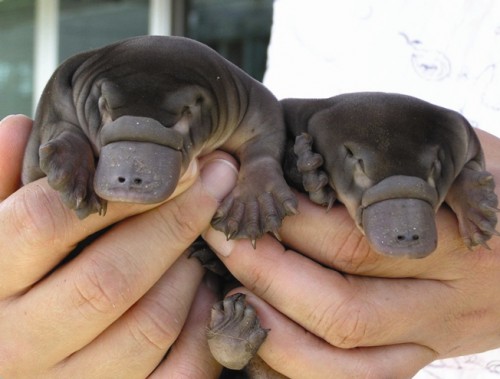
Platypus
The Platypus (Ormithorhynchus anatinus) is a warm-blooded, egg-laying mammal. They have no visible ears and webbed feet. On land the platypus walks on its knuckles with webbing tucked back. Platypus fur is fine and dense and is in two layers to keep them dry and warm. Besides being a stabilizer when swimming, the platpus tail is used for fat storage—up to 50% of the animal's body fat is in the tail.
They live in and near freshwater streams and lakes. Platypus burrows can be up to 100 feet in length and often have two entrances/exits. Their burrows are above water level with entrances in river or lake banks or under tree roots. There are two types of burrows: nesting and camping—the latter having shorter tunnels of 3 to 13 feet. Platypuses spend about 17 hours a day resting inside their burrows.
The platypus diet consists of freshwater invertebrates (shrimp, worms, pea-shell mussels) and aquatic insects. They also may eat frogs and fish eggs. The platypus mainly hunts at night. They use their bills to locate prey. Their bills have hundreds of receptors which respond to touch and tiny electric currents.
Platypus predators include: large cod, hawks, eagles, owls, and foxes. Carpet pythons, goannas and Australian water-rats attack young platypus in the burrow. Platypus prefer their burrows to be overhung by vegetation which helps hide it from predators. Adults usually have a number of burrows.
Platypus weigh 2.2 to 3.3 pounds and are 1.3 and 1.6 feet long. A platypus can temporarily store food in its cheek pouches. They don’t have teeth when grown but grind their food between pads in their bills.
Fun Platypus Facts
- The platypus bill is rubbery and flexible.
- Males have a sharp hollow spur on their hind ankles. These are venomous. The venom can kill a small animal or incapacitate a human.
- The female platypus lays a clutch of 1 to 3 leathery eggs. She does not have nipples, but instead secretes milk from two round patches of skin midway along her belly.
- In the early 1900's platypuses were hunted for their fur.
- They swim with their eyes, ears and nose shut.
- Platypus belong to the monotreme group, mammals who lay eggs.
http://www.thejunglestore.com/Platypuses

No comments:
Post a Comment